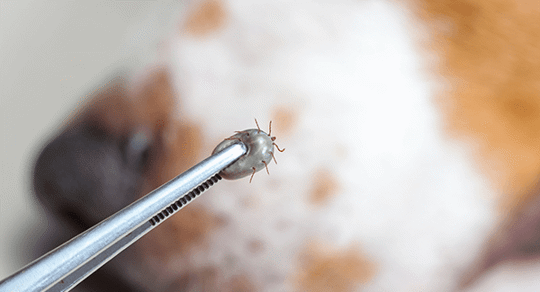Ticks and fleas are two very different pests in Connecticut that share some similarities in the way they infest properties and the problems they cause. For one thing, both species are parasitic and drink blood from mammals to survive. They are also both able to cause health problems for people and pests. Read on to learn more about flea and tick control in Connecticut.
What Do Ticks And Fleas Look Like?
Ticks and fleas are both rather small pests that are difficult to notice. Fleas are a reddish-brown color and less than 1/8 of an inch long. Ticks can range in color from brown to reddish-brown or yellow to black, and they have a variety of markings. They also have eight legs and are a type of arachnid. Fleas have a longer, thinner body shape while ticks are more round and flat.
How Infestations Begin
Both of these species bite animals and people, but the ways they move around are different. Depending on the species, ticks will use both people and various other mammals as hosts, while fleas only live on animals with fur and do not use people as hosts. However, while fleas may not live on us, they are just as happy to bite people as they are our pets.
Ticks will embed their heads into the skin of a host, where they drink their meal until they become engorged and fall off. On the other hand, fleas will live for more extended periods of time on the fur of pests or other animals.
As far as how the infestations of ticks and fleas begin, there are many similarities. If you have pets in the home, both ticks and fleas can be brought inside on their fur. Secondly, rodents and wildlife pests can bring ticks and fleas to your property. Ticks are more likely to be brought inside when they attach to your body after you’ve spent time outside, and fleas infestations occasionally begin when infested secondhand furniture is brought into a home.
The Problems Ticks And Fleas Cause
Ticks and fleas can both be quite dangerous. While not all bites will lead to illness, there is always a risk. To start with, ticks are known vectors of many illnesses such as Lyme disease and Rocky Mountain spotted fever. Fleas can spread diseases such as Bartonella and the bubonic plague.
Preventing Ticks And Fleas
Overall, the steps you can take to prevent these pests are quite similar. While flea and tick control aren’t easy, there are measures you can implement to make your property less appealing to them. Here is where to start:
- Prevent rodents by keeping kitchens clean, wiping up food and drink spills, and fixing leaky pipes and faucets to reduce excess moisture.
- Deter wildlife hosts by installing fences, removing bird feeders, and getting rid of standing water around the yard.
- Trim foliage around the property on a regular basis to get rid of areas where ticks tend to wait for a host to walk by.
- Get ongoing tick and flea control by contacting the residential and commercial pest control experts at Big Blue Bug Solutions.
As well as deterring ticks and fleas from your yard, you can also avoid picking ticks up while out and about by wearing long sleeves and pants, staying on trails, and checking for ticks when you come back indoors.
Learn More About Flea And Tick Protection
The best way to protect your property from ticks and fleas is with ongoing commercial or residential pest control services. Learn more about tick and flea prevention and removal by giving the pros at Big Blue Bug Solutions a call today.

